What is Project Portfolio Management
If you have ever worked for a manufacturing company, you might have wondered how they handle a huge number of projects. Is project management the answer? No! It has a separate name called project portfolio management. Organizations that have a huge number of projects often use Project portfolio management (PPM).
After reading this blog, you will get a clear idea about project portfolio management. You will also be able to understand the purpose of a PPM clearly.
Definition of Project Portfolio Management
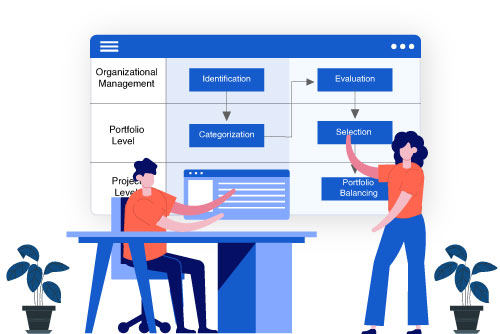
Every organization has some kind of strategic goal to achieve. Project portfolio management is the proper arrangement and execution of projects so that it follows the business strategy. PPM ensures that the employees remember the overall business goals and not just small achievements.
A project portfolio manager or a project management team drafts the project portfolio management. The project manager/PMOs must have a wider perspective about the organizational goals to manage this efficiently.
A PPM must answer the following questions in the organization:
- How to prioritize projects?
- How to run multiple projects?
- How to avoid unwanted expenses?
- How to keep every resource in check?
- How to make decisions for the long run?
Without an effective project portfolio management, the decisions made and the actions taken will fail to align with the business goals. Thus PPM proves to be an integral part of any organization.
Objectives of PPM
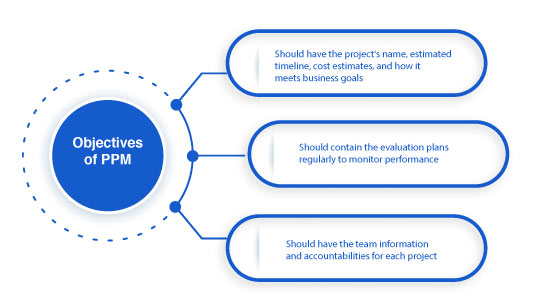
The first and foremost process in project portfolio management is establishing the objectives. The project portfolio manager designs a portfolio such that it blends well with the organization’s goals.
The project portfolio management’s objective must contain the following aspects:
- Should have the project’s name, estimated timeline, cost estimates, and how it meets business goals.
- Should contain the evaluation plans regularly to monitor performance.
- Should have the team information and accountabilities for each project.
Thus a good project portfolio management starts with the proper set up of objectives. This paves the path for a successful project portfolio development.
Phases of Project Portfolio Management
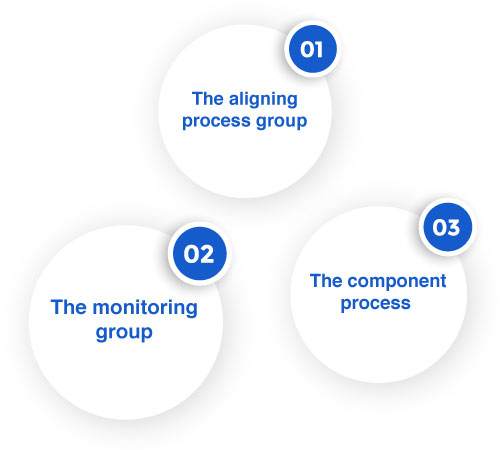
There are 10 PPM phases commonly identified by project portfolio managers. But they are generally grouped under three larger phases. They are:
1. The aligning process group:
This phase is also known as the preparation phase. It includes the following smaller phases:
- Identification: Listing all aspects that PPM is managing/will manage.
- Segmentation: Based on the type of business group, the grouping of projects takes place.
- Evaluation: Collect data from each component and assess them to further aid in categorization.
- Selection: Assign importance to each component from the list gathered.
- Prioritization: Based on strategic values, prioritize each project.
- Portfolio balancing: Create a business plan that adds value to the organization by arranging the projects in order.
- Authorization: Get approval for the created portfolio from the authorities. Must include all budgets, timelines, and resources to get it approved.
2. The monitoring group:
This phase is also called the execution phase of PPM. The phases grouped under this are as follows:
- Review and Report: In this phase, the project portfolio manager specifies all key performance indicators. These key performance indicators are for the whole PPM process and not just for a single project in it—these KPIs help track the progress of the portfolio.
- Strategic changes: Based on the report, you can now change/optimize your strategic plans to suit your business goals better.
3. The component process:
This phase of project portfolio management analyses the performance of each project in the portfolio.
- Component execution and reporting: Analysing and reviewing the performance of each component. This improves the overall quality of the project portfolio management process because the success of PPM depends on each project’s success.
Thus the project portfolio manager must always have the bigger picture in mind so that the projects’ execution is always favorable to the business strategies.
Project Portfolio Management Processes
We have already looked at what the phases of PPM are. In this section of the blog, we will look at the process involved in project portfolio management. The following are the commonly identified processes in PPM:
1. Change control management:
Since all projects are unpredictable, it is tough to follow the portfolio at all times strictly. Sometimes making changes for the situation benefits more than following the previously laid out portfolio. Change requests are common in an organization. A project manager issues a change request when there is a lot of demand for resources.
2. Risk management:

Do not confuse this with the risk management involved in project management. In portfolio management, the main subject of interest is the portfolio and not the project. This risk management is identifying problems in the portfolio that might lead up to potential risks. Having a contingency plan for each risk predicted is the best way to handle them.
3. Financial Management:

Perfectly managing the financial part of the projects to suit your business needs is financial management. The project portfolio management involves this process to keep the goals and finances in check at all times.
4. Pipeline management:
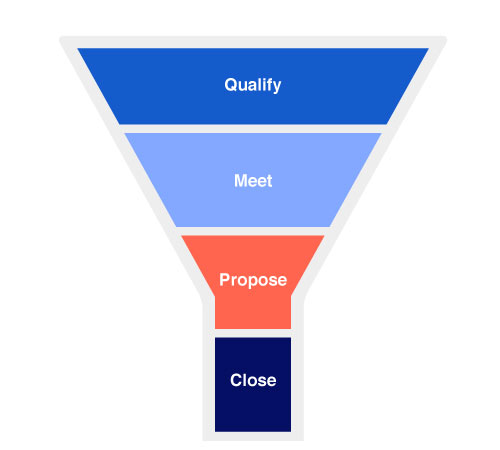
This is making sure whether the project fits in with the business goals. It also makes sure that it suits the pipeline of the current project portfolio.
5. Resource management:
Resources don’t only involve time, cost, and materials. It also involves the human resources needed to complete the projects in the portfolio. Managing an employee’s schedule for different projects also comes under resource management.
These are the processes that make up a project portfolio management. They are very similar to project management. The only difference is that project management focuses only on the success of one project. At the same time, project portfolio management focuses on all projects in an organization’s business journey.
Benefits of Project Portfolio Management
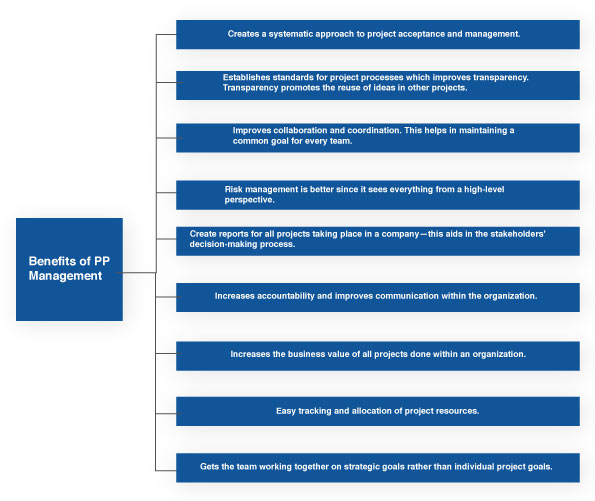
Implementation of a successful PPM process benefits an organization in many ways, saving a lot of time and resources. The following benefits are the ones quite important to all kinds of organizations:
- Creates a systematic approach to project acceptance and management.
- Establishes standards for project processes which improves transparency. Transparency promotes the reuse of ideas in other projects.
- Improves collaboration and coordination. This helps in maintaining a common goal for every team.
- Risk management is better since it sees everything from a high-level perspective.
- Create reports for all projects taking place in a company—this aids in the stakeholders’ decision-making process.
- Increases accountability and improves communication within the organization.
- Increases the business value of all projects done within an organization.
- Easy tracking and allocation of project resources.
- Gets the team working together on strategic goals rather than individual project goals.
- Allows for improvement and changes in the project management process without deviating from strategic goals.
These are the ways an organization can gain from employing effective PPM. You should note that project portfolio management is all about the bigger picture. It includes the project’s success as milestones and not an end-result.
Effects of poor PPM
All the benefits mentioned above are only possible if you maintain a good PPM. What happens when the execution of PPM fails terribly? The following are the possible effects of a poorly managed project portfolio:
- Authorities are unsure about which project to approve and which not to.
- Accepting more projects than the organization can handle.
- Too many project delays due to the lack of resources.
- Employee resignation rate increases due to overburdening them with projects.
- Increase in demand for resources within the organization. This highly affects the collaboration between teams.
So the next time you think about ignoring the need for project portfolio management, reckon these points.
Project portfolio management tools
With the recent technological improvements on cloud-based and desktop-based applications, managing a portfolio has never been easier. But there are a plethora of options. If you are wondering how to get the right one, look for the following features:
- See all your projects together in the same place
- Get live info about the progress of your project
- Collect detailed data about the projects
- Assign the right number of tasks per person
- Change the status of projects easily from anywhere
- Real-time monitoring of the portfolio
PeppyBiz is your one-stop destination if you are looking for all these features packed in one. Our project management software comes with Kanban boards to easily visualize the tasks assigned. Our software is also one of the best in the market, giving you all management tools under one platform. It comes integrated with AI and machine learning to enable faster movement of the portfolio.
With our project management software, you can assign and monitor tasks from any platform. Using Gantt charts, you can easily convey the time overlaps of each project in your portfolio. You can also specify the dependencies of projects easily using our software. You can check out the features of our software and other services we offer here.
Conclusion
To sum up, project portfolio management is one of the vital aspects of any business. It enforces a business goal with every project an organization undertakes. It also prevents the wastage of resources. So why wait? Schedule a free demo today at PeppyBiz to learn more.



